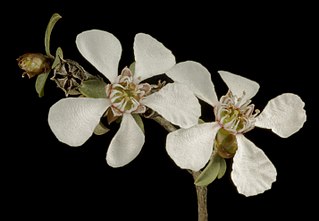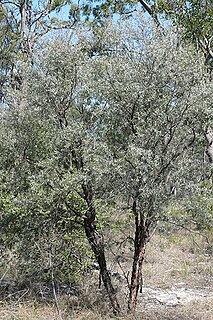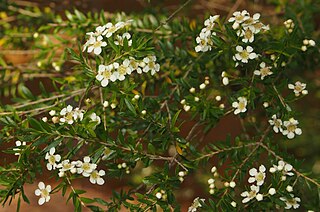
Leptospermum nitidum, commonly known as shiny tea-tree, is a species of compact shrub that is endemic to Tasmania. It has crowded, aromatic, elliptical leaves, white flowers about 15 mm (0.59 in) in diameter and fruit that remain on the plants until it is burned or dies.

Leptospermum continentale, commonly known as prickly tea-tree, is a species of slender, straggling shrub that is endemic to south-eastern Australia. It has sharp-pointed, narrowly egg-shaped leaves, white flowers arranged singly in leaf axils and woody fruit that remains on the plant when mature.

Leptospermum erubescens, commonly known as the roadside tea tree, is a species of shrub that is endemic to southwest of Western Australia. It has thin, fibrous bark, egg-shaped leaves, small white flowers and woody fruit.

Leptospermum exsertum is a small, sparsely branched shrub that is endemic to Western Australia. It has thick, wedge-shaped to heart-shaped leaves with the narrower end towards the base, often with a sharply pointed tip, white flowers arranged singly or in groups of up to three and fruit that falls off when mature.

Leptospermum fastigiatum is a shrub that is endemic to the south-west of Australia. It has narrow egg-shaped leaves with the narrower end towards the base and a small point on the tip, white flowers arranged singly or in pairs on short side shoots and small fruit that fall off when mature.

Leptospermum inelegans is a species of straggly shrub that is endemic to Western Australia. It has only partly hairy young stems, egg-shaped to narrow elliptical leaves on a short petiole, relatively small white or pink flowers and fruit that fall from the plant when mature.
Leptospermum macgillivrayi is a species of small, widely-branching shrub that is endemic to Western Australia. It has hard, knobbly bark, broadly egg-shaped leaves, flowers arranged singly on short side shoots and small fruit that fall from the plant at maturity. It is only known from two locations in the inland of the state.
Leptospermum maxwellii is a species of often low-growing shrub that is endemic to Western Australia. It has thin, flaking bark, egg-shaped leaves, white flowers arranged singly on short side shoots and fruit with the remains of the sepals attached.

Leptospermum oligandrum is a species of erect, spreading shrub that is endemic to the south-west of Western Australia. It has broadly egg-shaped to wedge-shaped leaves, white flowers arranged singly or in groups of up to three on the ends of short side branches and fruit that fall from the plant shortly after the seeds are released.
Leptospermum roei is a species of spreading shrub that is endemic to the southwest of Western Australia. It has thin, fibrous bark, long egg-shaped to narrow wedge-shaped leaves, white or pink flowers and small fruit that are shed with the seeds.
Leptospermum sericeum, commonly known as the silver tea tree, is a species of shrub that is endemic to the south-west of Western Australia. It has thin, firm bark, egg-shaped leaves with the narrower end towards the base, relatively large, pink flowers and fruit that fall from the plant with the seeds. It grows in windswept rock crevices near Esperance.
Leptospermum subtenue is a species of small shrub in the family Myrtaceae and is endemic to Western Australia. It has thick, elliptical, concave leaves, white or pink flowers and fruit that falls from the plant when mature. It occurs to the south of Kalgoorlie.

Leptospermum glaucescens, commonly known as the blue-green tea tree or smoky tea tree, is a species of shrub or small tree that is endemic to Tasmania. It has elliptical to egg-shaped leaves that are often greyish green, white flowers about 15 mm (0.59 in) in diameter arranged in consecutive leaf axils and fruit that remain on the plant for some time after maturity.

Leptospermum blakelyi is a species of shrub that is endemic to rocky clifftops near Lithgow in New South Wales. It has densely silky young stems, egg-shaped to elliptical leaves and white or pink flowers.

Leptospermum lamellatum is a species of shrub or small tree that is endemic to inland Queensland and has distinctive reddish, layered bark. It has narrow elliptical leaves, white flowers and small fruit that fall from the plant when mature.
Leptospermum microcarpum is a species of shrub that is endemic to eastern Australia. It has elliptical to lance-shaped leaves with a sharp point on the tip, white flowers and small fruit that falls from the plant shortly after the seeds are released.

Leptospermum neglectum is a shrub or small tree that is endemic to Queensland. It has elliptical leaves that are silky-hairy at first, white flowers on short shoots in leaf axils and fruit with the remnants of the sepals attached but that fall from the plant shortly after the seeds are released.
Leptospermum polyanthum is a rigid, spreading shrub or small tree that is endemic to New South Wales. It has thin, rough bark, young stems that are hairy at first, elliptical leaves, relatively small white flowers and fruit are shed when the seeds are mature.

Leptospermum purpurascens, commonly known as the purple-stemmed turkey bush, is a shrub or small tree that is endemic to far north Queensland. It has bark that is purple when new, elliptical to broadly lance-shaped leaves, relatively small white flowers arranged in pairs and small fruit that falls from the plants when the seeds are released.

Leptospermum sericatum is a species of erect shrub that is endemic to Queensland. It has thin, firm bark, narrow egg-shaped to elliptical leaves, white or pink flowers arranged usually singly on side shoots and fruit that falls from the plant when the seeds are released.














